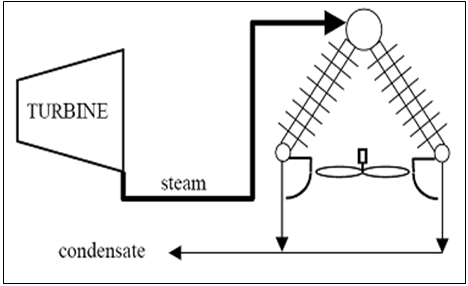Dry Cooling
Dry cooling systems (Figure 1) can be categorized as either direct or indirect.

Air cooled condenser (ACC)
Air cooled condensers (ACC) are an example of a direct dry cooling system. For ACC systems, steam from the turbine is routed directly to an array of A-framed tubes and a fan blows air directly across the array, convectively condensing the steam.1 Dry cooling systems use approximately 95 percent less water than wet systems2, and are becoming more common in thermal power plants. But they require higher capital costs, higher auxiliary operating power, and result in lower overall power plant performance, especially on hot days when peak power is needed most.3 According to one study by the National Renewable Energy Laboratory, dry cooling systems impose a seven to nine percent penalty on the levelized cost of energy.4
Indirect dry cooling (Heller System)
Indirect cooling, or Heller systems, use air as a secondary cooling medium. The primary cooling medium is still water, but the cooling water flows in a closed system and is never in contact with the cooling air. The heat transfer between air and cooling water is achieved with convection rather than evaporation as in wet cooling systems. An additional advantage is that Heller Systems do not require water to be replenished and have been found to consume roughly 97 percent less water than wet cooling systems with minimal impact on plant performance - roughly one percent increase in levelized cost of electricity.5 The tradeoffs are a higher initial investment cost and higher long term operating costs.
1 Michael Hogan, “The secret to low-water-use, high-efficiency concentrating solar power”, Climate Progress, http://climateprogress.org/?s=Michael+Hogan.
2 EPRI and California Energy Commission, “Comparison of Alternate Cooling Technologies for California Power Plants: Economic,Environmental, and Other Tradeoffs”, Sacramento, CA: 2002.
3 Kelly, B. (2006), Nexant Parabolic Trough Solar Power Plant Systems Analysis; Task 2 Comparison of Wet and Dry Rankine Cycle Heat Rejection, National Renewable Energy Laboratory, NREL/SR-550-40163.
4 Kelly, B. (2006), Nexant Parabolic Trough Solar Power Plant Systems Analysis; Task 2 Comparison of Wet and Dry Rankine Cycle Heat Rejection, National Renewable Energy Laboratory, NREL/SR-550-40163.
5 Jürgen Dersch and Christoph Richter, Institute of Technical Thermodynamics, Deutsches Zentrum fur Luft-und Raumfarht Study, “Water saving heat rejection for solar thermal power plants”, 2007.
